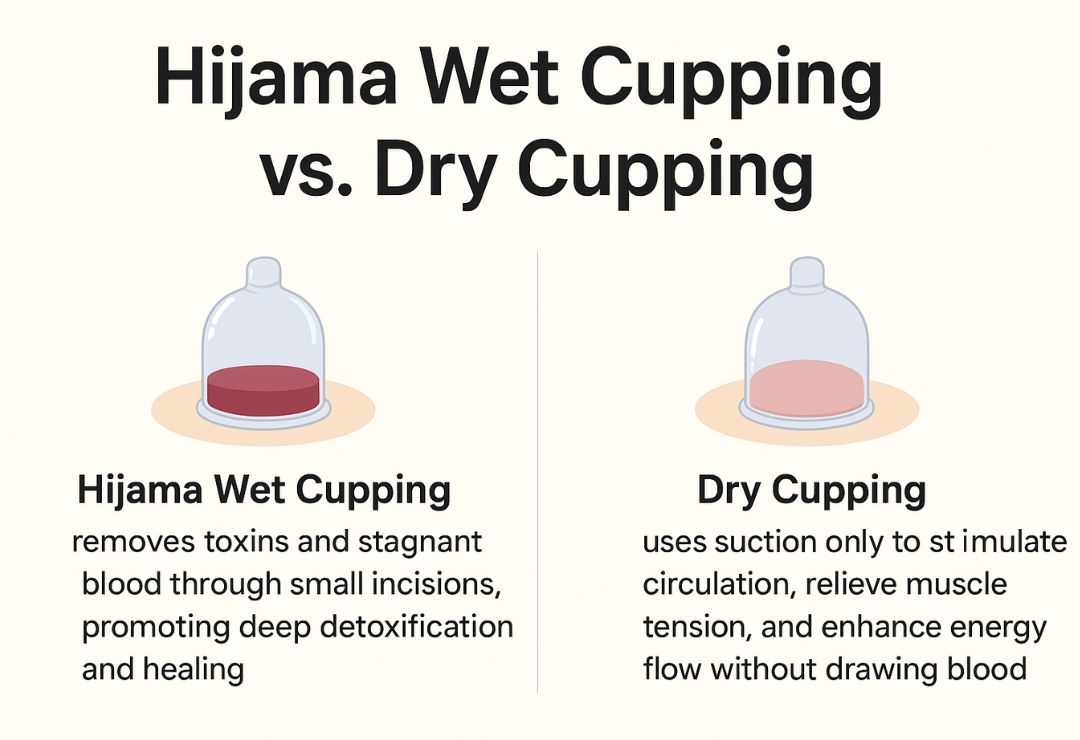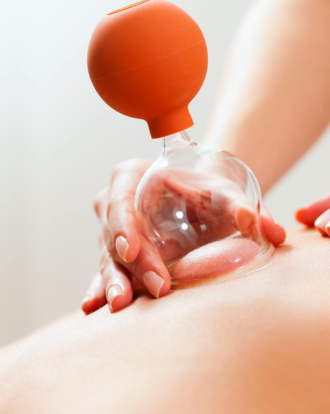Hijama Wet Cupping removes toxins and stagnant blood through small incisions, promoting deep detoxification and healing. Dry Cupping uses suction only to stimulate circulation, relieve muscle tension, and enhance energy flow without drawing blood.
Cupping therapy has gained popularity worldwide for its potential health benefits, from pain relief to improved circulation. Among the various types of cupping, Hijama (wet cupping) and dry cupping stand out as two of the most widely practiced techniques. If you’re curious about how these methods differ and which one might suit your needs, this guide breaks down the key differences, benefits, and applications of Hijama wet cupping and dry cupping.
What Are the Types of Cupping?
Cupping therapy involves placing suction cups on the skin to promote healing, reduce pain, and enhance overall well-being. The two primary types of cupping are:
- Hijama (Wet Cupping): A traditional therapy combining suction with controlled bloodletting to remove toxins and improve blood flow.
- Dry Cupping: A non-invasive technique that uses suction alone to stimulate muscles and tissues without breaking the skin.
Understanding these types of cupping can help you choose the right approach for your health goals. Let’s dive into the specifics of each method.
Unveil Your Next Chapter With Dynasty
Our dedicated team is here to answer your questions and guide you on your path to well-being. Get in touch today to schedule a consultation or explore our services.
What Is Hijama Wet Cupping?
Hijama, also known as wet cupping, is an ancient therapeutic practice rooted in traditional Islamic medicine, though it’s also used in various cultures worldwide. This type of cupping involves creating suction on specific points of the body using cups, followed by small incisions to draw out a small amount of blood.
How Does Hijama Work?
- Suction: Cups are placed on the skin, typically on the back, shoulders, or other targeted areas, to create a vacuum that draws the skin upward.
- Incisions: After a few minutes, the cups are removed, and small, superficial incisions are made on the skin.
- Blood Removal: The cups are reapplied to draw out a small amount of blood, believed to remove toxins and stagnant energy.
What Is Dry Cupping?
Dry cupping is a non invasive form of cupping therapy that focuses solely on suction without any bloodletting. It’s widely used in sports therapy, wellness clinics, and holistic practices to relieve tension and promote relaxation.
How Does Dry Cupping Work?
- Suction Applicationinig: Cups (often made of glass, silicone, or plastic) are placed on the skin, creating a vacuum that lifts the skin and underlying tissues.
- Duration: The cups remain in place for 5–20 minutes, depending on the treatment goal.
- Release: The cups are removed, leaving temporary circular marks that typically fade within a few days.
Which Type of Cupping Should You Choose?
Your choice depends on your goals and comfort level. Choose Hijama Wet Cupping if:
You want detoxification or relief from chronic issues. You’re comfortable with small incisions and bloodletting. You prefer a traditional healing approach.
Choose Dry Cupping if:
- You want a gentle, non-invasive therapy. You’re an athlete or need muscle recovery. You’re new to cupping and want a simple start.
Safety and Precautions for Both Types of Cupping
Regardless of the type of cupping you choose, safety is paramount:
- Certified Practitioners: Ensure your therapist is trained and certified in cupping therapy.
- Sterile Equipment: For Hijama, sterile tools are critical to prevent infections.
- Health Conditions: Avoid cupping if you have bleeding disorders, skin infections, or are pregnant, unless approved by a healthcare provider.
- Aftercare: Stay hydrated, avoid strenuous activity, and keep the treated area clean.

Conclusion: Exploring the Types of Cupping
Both Hijama wet cupping and dry cupping offer unique benefits, making them popular types of cupping for different health needs. Hijama is ideal for those seeking detoxification and holistic healing, while dry cupping excels in muscle relaxation and stress relief. By understanding the differences between these types of cupping, you can make an informed decision about which therapy suits your lifestyle and wellness goals.
Ready to try cupping therapy? Consult a professional to explore these types of cupping and discover their transformative benefits today!
Disclaimer: Always consult a healthcare professional before starting any new therapy, especially if you have underlying health conditions.
Book an Appointment
It’s easy and free!







